The time has come and you are ready to head out on your first or second day hike! No matter how seasoned of a hiker you are, we all remember the first time we set out on our first day hike and how nervous we were, yet how exciting it all felt. After checking the weather and getting excited to hit the trail, you have to ask yourself “what do I need to take to keep me safe and comfortable on my journey”.
If you are asking yourself this right now, please know that you are not alone! We vividly remember especially during our first year of hiking how many trials and errors we went through on what gear we actually needed versus what was just unnecessary for most hikes. If you want to test yourself and a relationship then just run out of snacks while having Vic on an all-day hike… things do not end pretty.
We are sure that like us you have been everywhere online trying to find out exactly what you need to have an amazing day on the trail without carrying 50lbs of gear. What we have found out is that most lists online include so many items that are truly unnecessary and most hikers will never need half of them on the trail.
What we have done is create our essential checklist that can get us through most if not all of our day hikes without sacrificing comfort or safety.
(A small caveat is while we do recommend some brands because we value their company ethos and quality of their products, you can almost always find a much cheaper and just as usable alternative at local places like Target or Walmart. Price for outdoor gear should never be a barrier of entry for anyone wanting to get into the outdoor world.)
Whether you are an experienced hiker or are just starting out, here are the day hiking essentials you should bring with you on every hike.
1- Backpack
The first thing you need for any day hike is of course a good hiking backpack. While you can get away with just a basic JanSport backpack from your school days if you are not going too far, for longer distances you might opt for something with more support.
Any backpack can get you through a hike but comfort will play a big role in how long you will hike and if you will hike again. A cheap backpack without the correct support or straps that cut into your shoulders and chest is a quick recipe for hating your time outdoors. Now this doesn’t mean you need to hit your local REI and buy the most expensive and technical backpack out there. In all honesty even we do not spend too much on our day packs and think there is little need to go over the $100 mark.
For size we think hovering around the 18–22-liter mark is a perfect day pack spot and will prevent most beginners from overpacking. While you might think that a bigger backpack will be useful down the road, we live by the mantra that “if there is space, we will fill it”. The moment you get a 35-liter pack for a day trip even if it compresses down, you will quickly find a way to add extra items that are just unnecessary and will drag you down.
Your best bet to make sure you find a good day pack is to head down to your local outdoor store like REI and trying the backpacks on there. There are just so many different body types that it is hard to say “this is the holy grail of bags”.
There are a few things that are a MUST for day packs if you will be purchasing a hiking specific backpack.
- Hydration Sleeve/Bladder – some backpacks will bring a bladder while other will just have a pocket to hold one. Having a specific place to hold your hydration bladder is key to be comfortable and not have a big bag of water sloshing around your back while hiking.
- Sternum strap – this might be new to most first-time hikers but the sternum strap (the one that goes across the chest) is crucial to assist with easing the load on the shoulders and back.
- Hip belt – this one is crucial for many but as Gus will testify while being a big guy most hip belts might also be uncomfortable.
Our top recommendations for beginner daypacks are two very similar packs that will serve any hiker well for many years. We actually have both of these backpacks and have used them for years not just in the U.S., but abroad on the Inca Trail and other South American regions.
- REI Flash 22 – https://www.rei.com/product/185564/rei-co-op-flash-22-pack
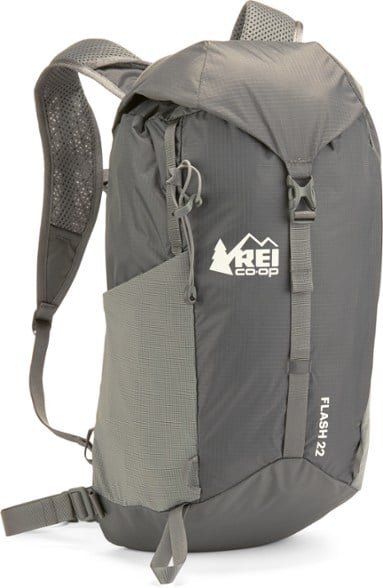
This was one of Gus’s first hiking packs ever when he started to get into hiking and over 5 years later it is still going strong! One of the reasons we also recommend this bag highly is that it is almost always on sale at REI during their seasonal offers.
We love this pack due its lightweight, simple design and flexibility in storing everything we could need for a day hike. One downside to this bag is the fact that it doesn’t have a solid back panel so some people might find it uncomfortable if you have sharp or weird shaped objects in the bag. Luckily with a hydration bladder inside that normally isn’t a big problem.
While it does not include a hydration bladder due to its low price you are easily able to purchase a separate bladder at the store and slide it into the pocket in the back.
- Gregory Nano H20 18L Hydration Pack – https://www.rei.com/product/165342/gregory-nano-h2o-18l-hydration-pack-3-liters
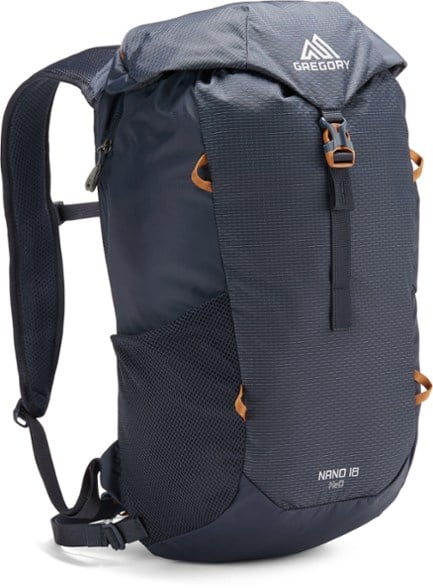
The second backpack we recommend, and Vic’s current day-pack, is the Gregory Nano, which we also got on sale and has served us well for over 2 years so far. The pack is lightweight as well, holds more than what we would need for a day hike but also prevents packing too much with its small size.
One benefit this one has over the Flash is the stronger and more breathable back panel as well as coming already with a hydration bladder versus having to purchase it separately.
2- Hiking Clothing and Layers
Some of the most important day hiking gear will be what you wear on and around your body. Hiking in layers is crucial no matter what season you are adventuring in for comfort and safety. While there is technically no special requirement for hiking clothing and almost all our hiking clothing is regular workout clothing there are quite a few important details that can make your day hike better.
Depending on the season and time of year your requirements will drastically vary but there are staples that every beginning hiker should aim to accumulate over time.
Base Layers
We always talk about layers when hiking, since even in the coldest winters there will be times when you will get slightly warm from hiking. It is fascinating how much heat your body can produce over time while hiking.
Year round or base layers do not change much we always wear moisture wicking fabric such as workout t-shirts because once again even in the dead of winter you will start sweating while you hike.
One thing that normally confuses beginners is why we recommend wearing long sleeve shirts while hiking even in the summer. Some might think the less fabric the better but it will drastically protect you from the hot sun in open areas, and as long as it’s a breathable material you won’t get too warm.
Mid Layers
In our mid layer range, we normally carry a lightweight fleece and go up from there depending on the weather. Even in the coldest winter we layer up once again due to how much heat your body can produce. We are big fans of REI, Patagonia and North Face quarter zips and their long-lasting quality.
Outer Layer
Depending on season and weather, this list could dramatically change.
Firstly, we recommend a good rain jacket if there is even a slight chance of rain while you are on the trail. There is almost nothing worse than being caught on the trail in the pouring rain with a cheap poncho or nothing at all.
When it comes to winter layers a solid puffy jacket like a Patagonia Nano Puff (https://www.rei.com/product/102404/patagonia-nano-puff-jacket-mens) is indispensable. A good quality puffy jacket is a staple to have, since it will be able to stuff itself into its own pocket and save a ton of space in your bag. Not only are they packable but even when wet can provide warmth that a fleece cannot do.
Hiking Footwear
Many people tend to neglect footwear – to this day we will never forget the guy sliding and tripping down Queen’s Garden Trail at Bryce Canyon because he thought he could hike in the snow and ice while wearing Yeezys. (Yes, that actually happened!)
On that note, unless you are doing an extensive all day hike most beginners can start off on a regular pair of running shoes. However, if you are planning on doing an all-day hike or weather will be iffy, then upgrading to a good pair of trail running shoes or hiking boots is worth the money.
The biggest benefit of trail running shoes or hiking boots is the protection your foot will get from stepping on rocks (you will realize how thin a regular Nike Free Sole is when you are hiking in rocky terrain) and the ankle protection a lot of them offer. Gus loved having his boots while hiking in Arkansas due to just how rocky the trail was!
We do need to point out that neither of our trail running shoes or hiking boots cost us over $100, but all can retail for over that. Looking up at REI Anniversary sale or Backcountry sales is the way to go when shopping for some of these big-ticket items.
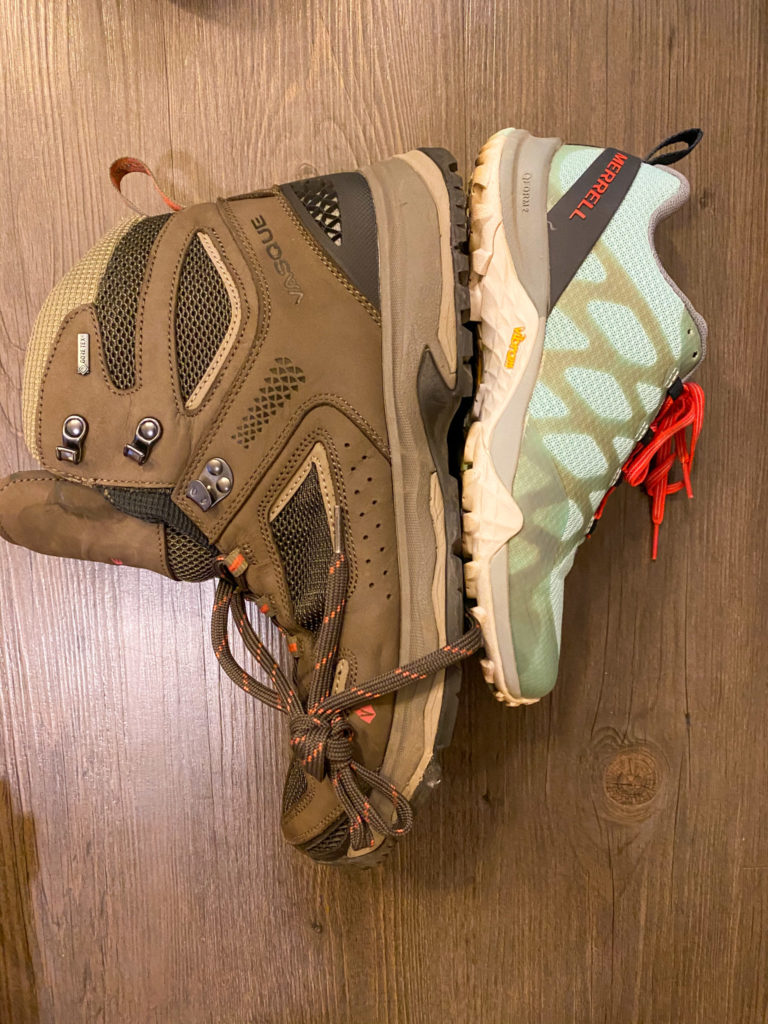
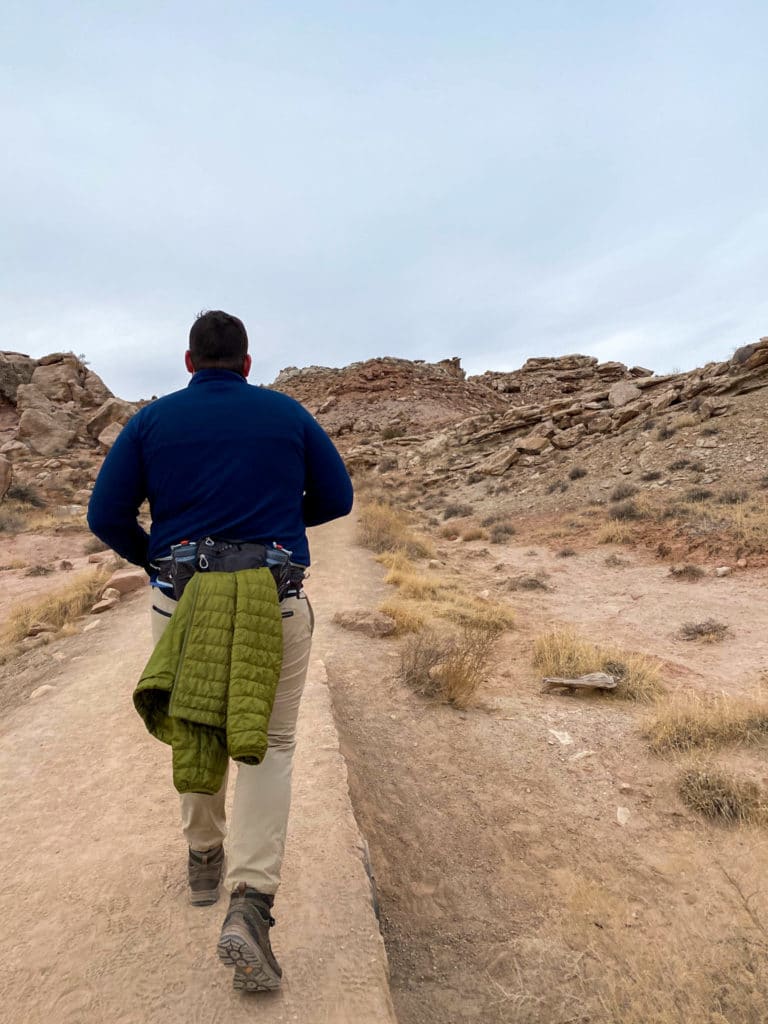
3- Sun Protection
As we mentioned earlier, sun protection is no joke while you are hiking in the outdoors. Many people might think this is only an issue in the summer, but we can promise you in the winter that snow and ice will reflect those rays right back at you!
This is the reason that year-round we normally hike in long sleeve SPF shirts to make sure we are safe from the sun and do not have to slather ourselves in sunscreen all day long. We also always carry a good hats, sunglasses and our trusty neck gaiters.
4- Water… and more water
This might seem like a no brainer to many, but the amount of times we have seen a hiker in the middle of summer in Texas heading on a half day hike with just one store bought water bottle is insane.
The reason we recommend a backpack with a hydration bladder is that 2-3 liters of water in a bladder is enough to get you through most if not all beginner hikes without issue.
As a side note hydration is not only important in the hot summer months, but it can also drastically help with elevation issues when you are hiking up in the mountains.
5- Snacks
Ok, snacks are important and we all know that, but how many people have headed out on a hike with just a bag of chips hoping for the best? Way too many if you ask us!
Now, it is not necessary to go to your local outdoor store like REI and buy all the fancy electrolyte filled snacks and gels. As a matter of fact, if you have never eaten these gels before, then your stomach might be in for a big surprise.
A better idea is to plan ahead and, depending on the length of your hike, decide what healthy and energizing snacks you might take with you. We are huge fans of a solid PB/J sandwich since it covers your carbs, protein and fats in one tasty snack. Other ideas are mixed nuts or granola bars.
At the end of the day make sure it is a snack that you enjoy and will find tasteful after hiking for quite some time. Also, remember to take a bit more than you think you need since being hangry on the trail is just the fast lane to a horrible day, or if you’re like Gus and say the trail will be 6 miles but it ends up being 10, you want to be ready.
6- First Aid Kit
A small first aid kit is an essential of any day hike pack we carry. Now to be clear we don’t mean carrying a full paramedic med kit, but a small kit that can carry some band-aids for cuts, Benadryl in case of a reaction to something on the trail and a few items that is included in most kits such as Neosporin or alcohol wipes.
We love this basic kit we got at REI due to its small size, waterproof case and flexibility since it is in a pouch and not a hard-shell case. It is also hard to beat the price at less than $20 with the option to easily buy refills at REI or as we do just refill with items we like from our local pharmacy.
7- Maps/Navigation Tools
A good hiking app is essential nowadays for navigating trails and of course for planning your hikes. We really like HikingProject.com for the ease of use and low-cost approach to hiking navigation. The app offers great options to download offline maps as well as being one of the best and easiest ways to map out a hike. It allows you, to join multiple trails together and gather all the information in one place, unlike most other apps that you may pay for.
Besides a trail app, a trusty park map which can be picked up for free at all State and National Park Visitor Centers is key to a successful day.
Lastly, as we have gotten more into hiking and gone on longer and more remote trails, we find having a GPS device a great addition to feeling safe and finding our way if we ever get lost. Currently we use a Garmin InReach Mini and have to say it is perfect for anything everyone, besides maybe a high-level adventurer, could need. With a low-cost monthly fee that can be started and stopped at any time, we are able to have SOS capabilities worldwide and track our hiking on an app on our phone, as well as have family members follow us when we are off the grid.
8- Flashlight or/and Headlamp
While not on most people’s list, a small flash light or headlamp will take almost no space in a bag, but could be a life saving device if you get stuck on the trail into the late hours of the night. You might not think you will be hiking in the dark, but it just takes one poorly planned hike for the sunset to catch you out on the trail and that small flashlight in the bottom of your bag to be a difference maker.
Below is our favorite headlamp which like usual with our budget friendly mindset is under $20!
Petzl Tikkina Headlamp – https://www.rei.com/product/162480/petzl-tikkina-headlamp
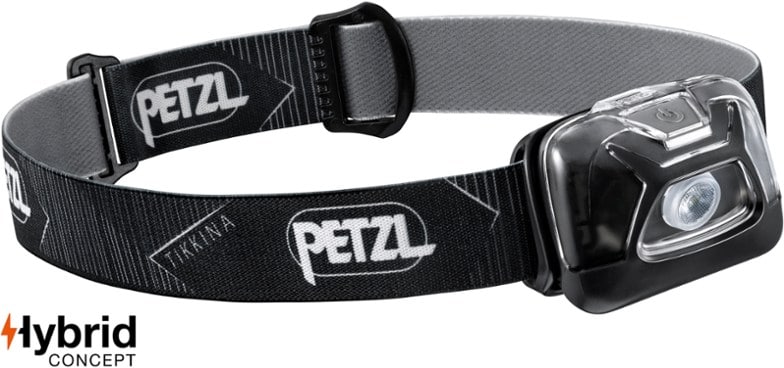
When it comes to a cheap flashlight we tend to go on Amazon and find a small pocket friendly floodlight that is perfect to toss in your bag and forget about. It is really easy to find $20 or less flashlights that will fit the bill and serve you for a long time.
Bonus Items!
9- Trekking Poles
Trekking or Hiking Poles are by no means a beginner item or an essential item required to hike but once you get used to them, they are a must have item.
We have both been using hiking poles for a while now and we can attest to how useful they are for steep, long hikes. Trekking poles take the pressure off your knees, give you more power on the ups, and help maintain a rhythm while you’re hiking.
There are a number of different hiking pole options but we love our REI Trekking Poles and they have treated us well for a long time now.
You can definitely get by with a cheaper pair of poles off Amazon for the short term to make sure you like them before stepping up to higher end poles if price is a barrier.
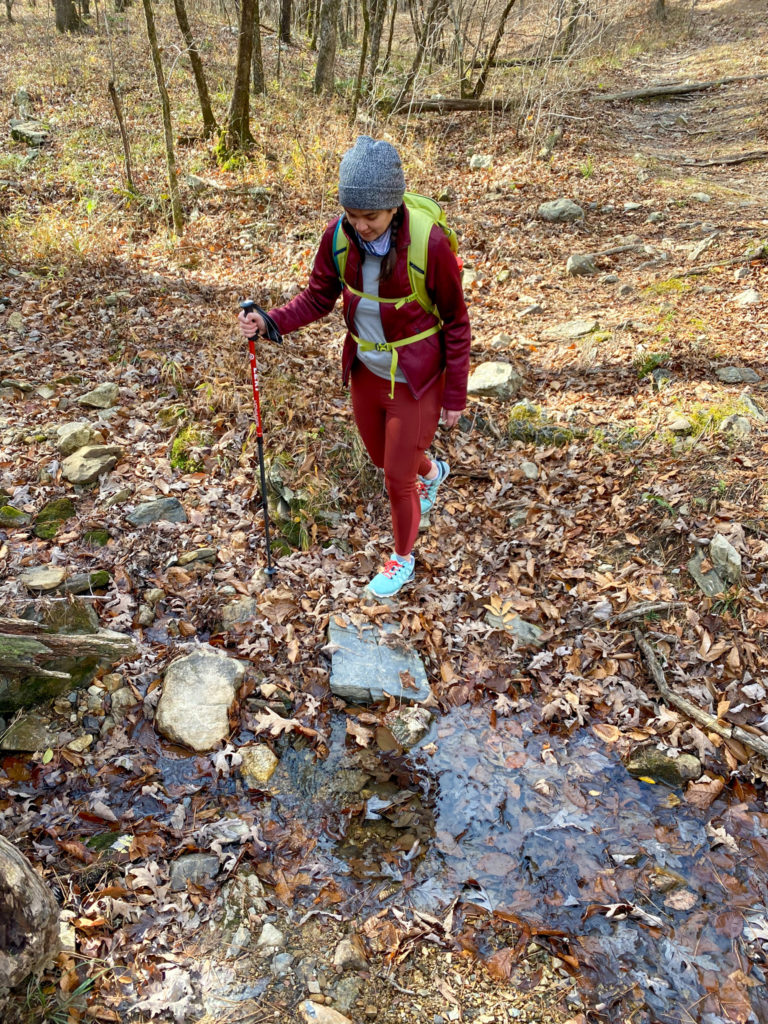
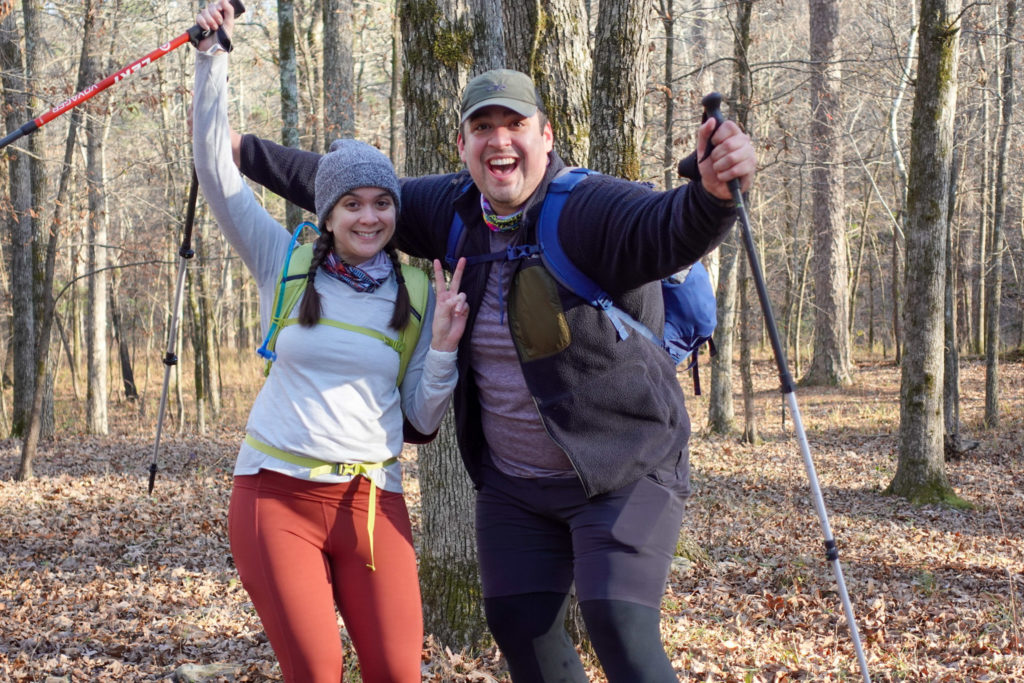
10- Multi-Tool and Survival Kit
A solid multi-tool and small survival/repair kit are certainly not a must have, but a good addition as you become more accustomed to being in the outdoors. Small tools like a Gerber or Leatherman are extremely useful for repairing small items like a trekking pole. A small survival kit is easily thrown in your bag and forgotten but can offer items like duct tape, fire starters, emergency blankets, etc. That can save your life in an emergency.
These are by no means necessary for beginners but can be a nice to have as you start tackling longer and more challenging hikes.

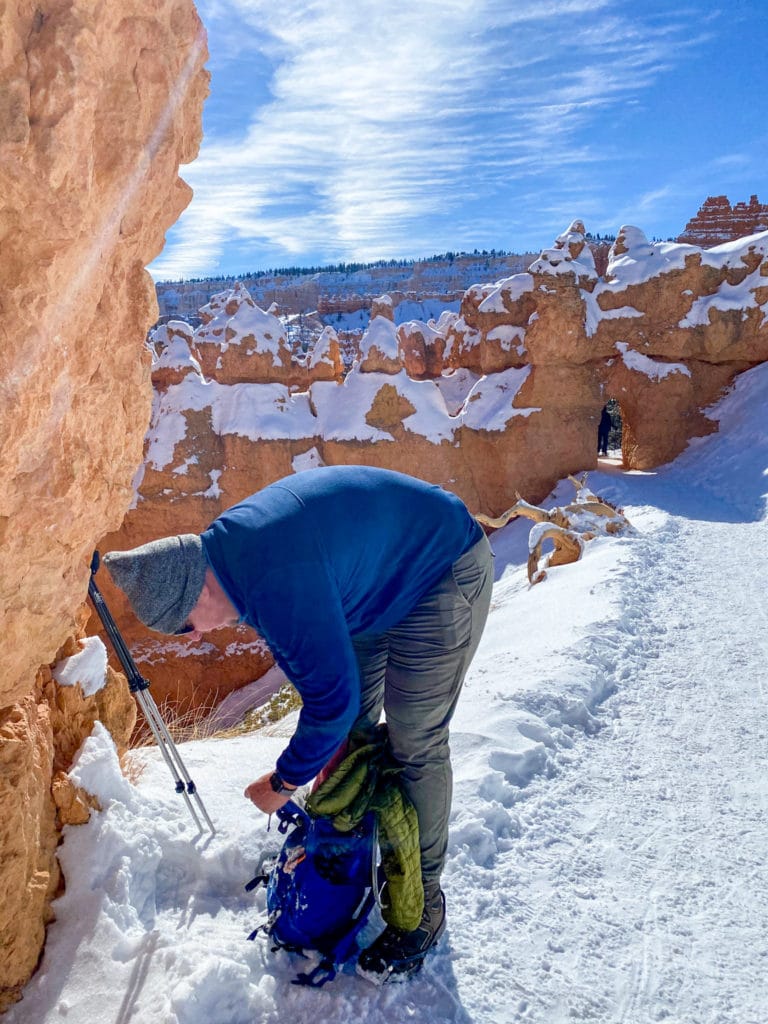
These are definitely our top 8 items plus 2 bonus items for all beginning hikers to have while on the trail. Anyone can hit the trail in what they normally go to the gym in, but there are so many things that can make your time in the outdoors more comfortable and safer.
At the end of the day, you have to find what will fit your hiking style. Luckily the more time you spend outdoors, the more you will understand what you need and what fits your style.
Do not let anyone put you down for not fitting their frame of what a hiker is or what a hiker carries. The best thing about being outdoors and exploring is creating your own mold of what that means. As long as you are comfortable and more importantly safe then that is exactly what you need to be carrying and doing.
We also recommend you to check out our top road trip items that we swear by for safety and comfort as well!
Keep exploring and keep sharing and hopefully we run into you one day!
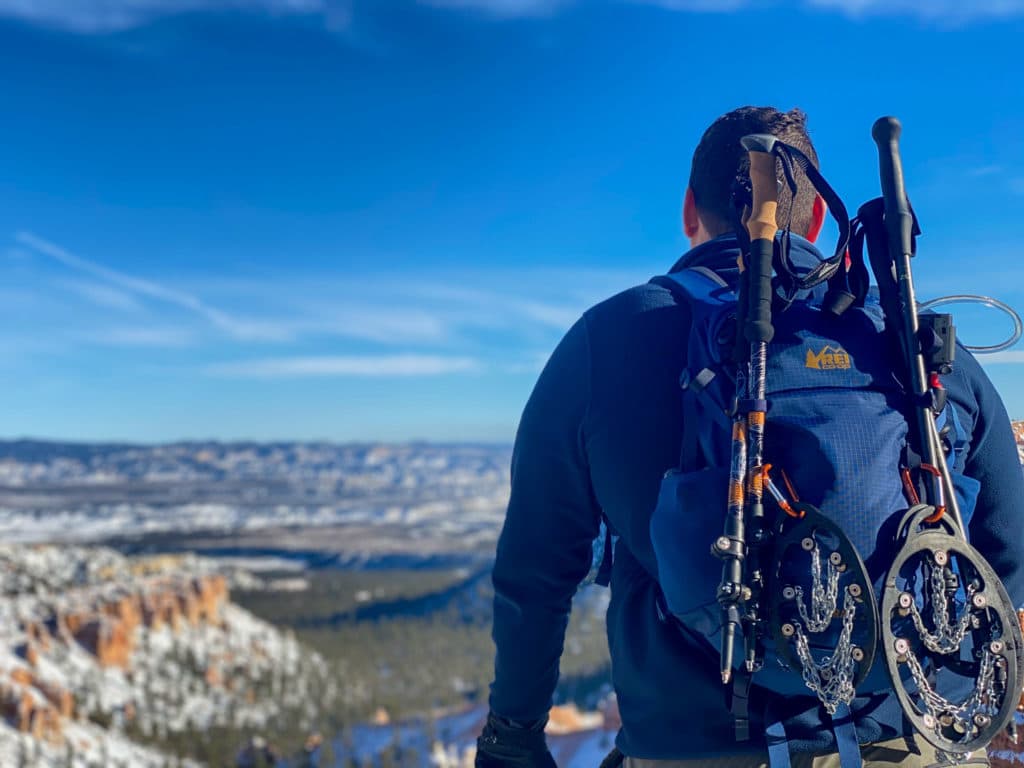



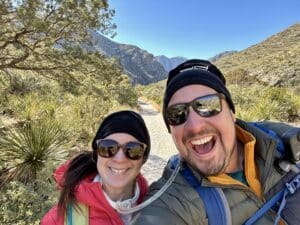
16 Responses
Great suggestions here. I don’t own a backpack and the thought of which is best to buy would concern me . Here you have good suggestions as to which one and why. I had never though of trekking poles to aid long upwards walks and now that you explain their benefit, I understand why they would be beneficial. Thanks for the info
Glad we could help! Always happy to see how we can help people getting into hiking.
Such great tips and awesome list! I love how passionate you are about hiking. The backpack really does seem so key. I’ve backpacked before (not as a hiker but just travelling between places) and almost always neglect the chest and hip strap. Definitely something I need to work on because I know it can make a big difference! And good to know that good shoes don’t have to be too expensive.
Glad we could help! We love hiking so much and just being outdoors helps us reset after working so much lol.
Definitely big advocates that hiking shouldnt be expensive to get into so def shop around!
Great post! This is so important and informational when you’re new to hiking and don’t know where to start. Especially with the backpack, I didn’t realize how much support having a waist and chest strap can give you until I got the Eagle Creek backpack for traveling. It makes life a whole lot easier.
Glad it helped! We think everyone should be prepped and ready for a hike and a few small items could make a hike so much more enjoyable!
Thanks for this essential list! You are so right about hiking boots helping the ankles… I only ever wear running shoes but I don’t go on very long hikes. If I did, I’d have to invest in hiking boots for sure. I was also wondering, can the poles collapse so they can fit in your bag if you aren’t using them? P.s. Your Bryce Canyon story made me wince…ouch!
We love our hiking poles and they definitely collapse decently small and strap easily to the back of our backpack in specific anchors.
I agree having the right equipment makes for a better hiking experience. By investing in the right footwear, clothing, tech, etc. it tricks your brain to say let’s make time for this, not just go out and do a random hike. I’m glad for the invention of hiking poles or sticks, this makes it much more essential for all hikers of all ages.
So true, the right gear truly makes a hike so much more enjoyable and safe!
This is the perfect list to being prepared for a hike because I’ve learned – the unexpected can happen! I also stash an extra charger for my phone 🙂
Such a good idea on the phone, we normally carry at least one battery pack on trips for that unexpected moment!
Glad the list could help!
I 100% agree with sunscreen after falling victim to this last week. I’m so guilty of forgetting to put it on. I couldn’t hike without my trekking pills right now. Another I always carry is a portable battery pack to keep my phone full for emergencies (and photos)
The portable battery pack is so important and we love and always carry ours! Sunblock is definitely a mistake we have made before but definitely wont make again after some of those sunburns!
This is a really great, comprehensive list of hiking necessities! Our go to snack is trail mix. The questions is, what kind of J do you use on your sandwiches? 😉
We love trail mix! Definitely on our list of must have snacks!
And we love some strawberry jelly all day everyday!